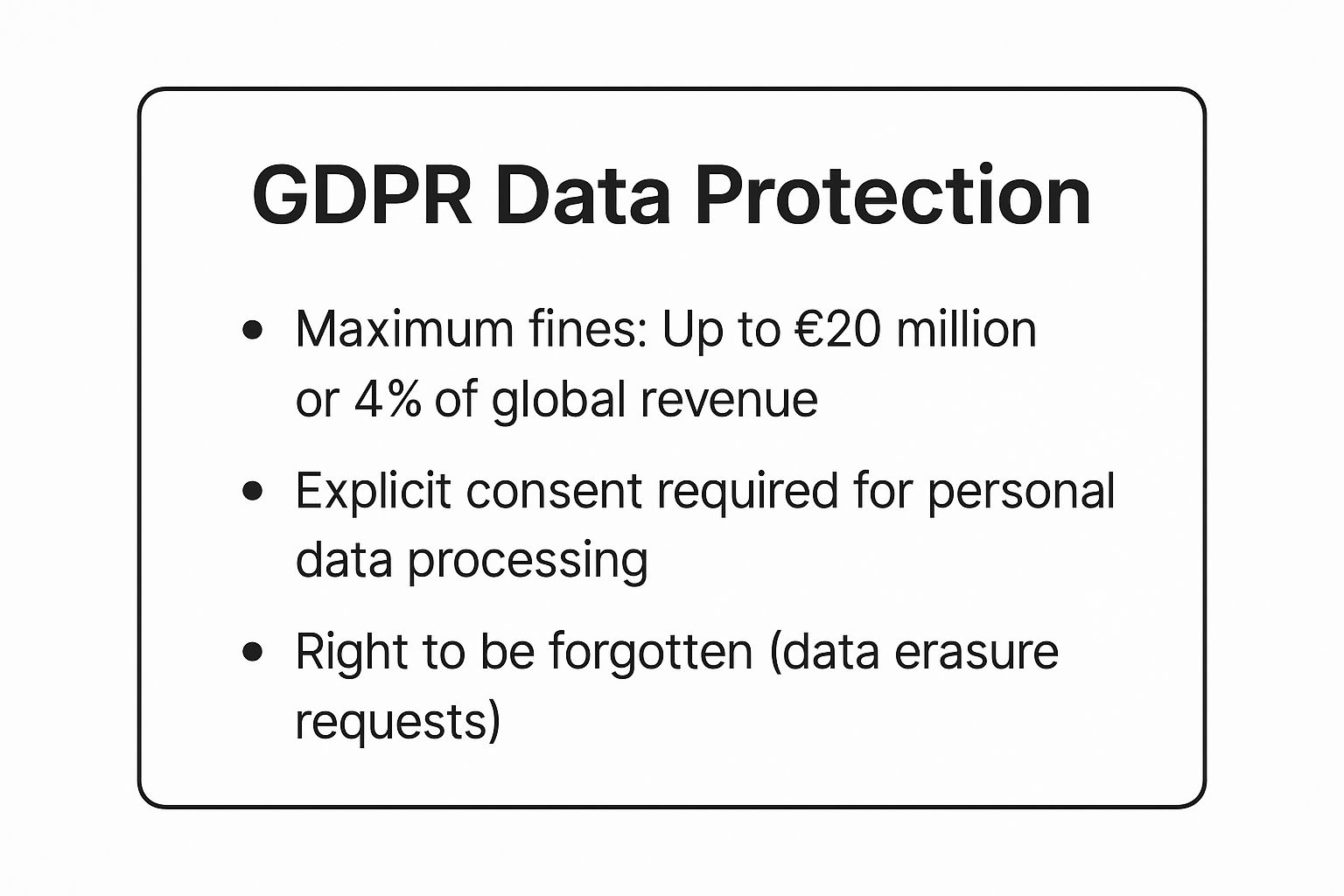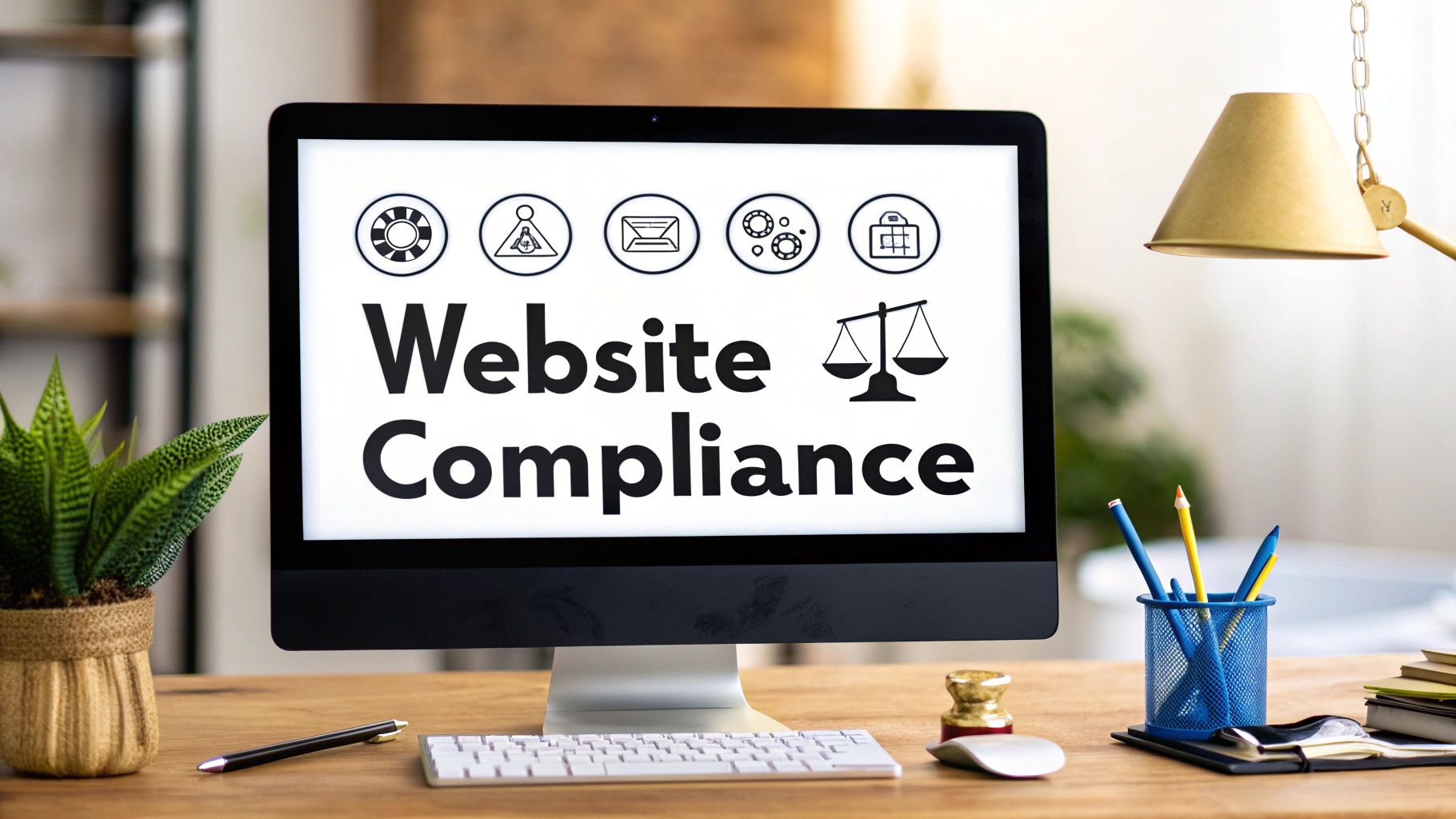Navigating the Maze of Digital Regulations: Is Your Website Truly Compliant?
In today's digital-first economy, your website is your business's central hub. Yet, beyond aesthetics and functionality lies a complex web of legal, technical, and accessibility regulations that govern the online space. From the General Data Protection Regulation's (GDPR) strict data privacy rules to the Web Content Accessibility Guidelines' (WCAG) essential mandates, non-compliance is a significant business risk. It can lead to substantial fines, legal disputes, reputational damage, and an irreversible loss of customer trust.
Many entrepreneurs and small to medium-sized businesses, particularly in regions like East Anglia, unknowingly operate non-compliant websites. This oversight leaves them vulnerable to severe penalties that could jeopardise their entire operation. This comprehensive website compliance checklist is engineered to demystify these critical requirements and provide a clear, actionable path forward.
We will break down the seven most crucial areas of website compliance, from data protection under GDPR and CCPA to technical security with SSL/TLS and accessibility standards. Each section provides practical implementation details to help you build a safer, more inclusive, and legally sound online presence. Think of this guide as your roadmap to transforming your website from a potential liability into a trusted, resilient asset. While this checklist focuses on compliance, ensuring your site is fully prepared for future regulations and industry standards requires a broader view; a deeper dive into its foundational needs can be gained from this ultimate website requirements checklist for 2025. Let’s begin securing your digital footprint.
1. GDPR Compliance for EU Data Protection
Topping our website compliance checklist is the General Data Protection Regulation (GDPR), a landmark data privacy law from the European Union. Even if your business is based in the UK, GDPR applies if you offer goods or services to, or monitor the behaviour of, individuals within the EU. It fundamentally shifts the responsibility of data protection onto organisations, requiring a proactive and transparent approach to handling personal information.
At its core, GDPR mandates that you have a lawful basis for processing any personal data. For most websites, this means obtaining explicit, unambiguous consent from users before collecting their information via cookies, forms, or other tracking technologies. This consent must be freely given, specific, informed, and easily withdrawable. A simple "by using this site, you agree to our policies" banner is no longer sufficient.
Why GDPR is a Crucial Compliance Pillar
Ignoring GDPR can have severe financial and reputational consequences. The regulation empowers data protection authorities to impose substantial fines for non-compliance. Beyond the penalties, adhering to GDPR builds trust with your audience. Demonstrating that you value and protect their privacy can become a significant competitive advantage, encouraging loyalty and engagement from security-conscious consumers. This framework sets a global standard for data rights, making it an essential foundation for any comprehensive compliance strategy.
Practical Implementation and Examples
Successfully integrating GDPR requires more than just a privacy policy update; it demands systemic changes to how you manage data. A key first step is conducting a thorough data audit to map every piece of personal information your website collects, where it's stored, why you collect it, and who has access.
Consider the approach of major tech companies as a model. Spotify, for example, provides users with a clear privacy centre where they can see precisely what data is collected and manage their preferences with granular control. Similarly, Microsoft offers a comprehensive privacy dashboard that allows users to view, manage, and delete their data, directly fulfilling GDPR's requirements for data subject rights, such as the right to access and the right to erasure.
To streamline this process, many businesses implement Consent Management Platforms (CMPs). These tools automate the collection and management of user consent for cookies and trackers, ensuring your practices remain compliant without constant manual intervention. They present clear choices to visitors and log their consent preferences, creating a vital audit trail.
To help you grasp the most critical aspects of this regulation, the summary box below highlights its core pillars.

These key takeaways underscore the seriousness of GDPR, combining steep financial penalties with stringent requirements for consent and user control over their data. Your compliance efforts must address these non-negotiable elements to be effective.
2. WCAG 2.1 AA Accessibility Standards
A fundamental part of any modern website compliance checklist is adherence to the Web Content Accessibility Guidelines (WCAG). Specifically, WCAG 2.1 Level AA is the globally recognised benchmark for creating digital experiences that are accessible to people with a wide range of disabilities, including visual, auditory, motor, and cognitive impairments. Developed by the World Wide Web Consortium (W3C), these guidelines are not just best practice; they are a legal requirement in many countries, including under the UK's Equality Act 2010.

The framework is built on four core principles, often remembered by the acronym POUR: Perceivable, Operable, Understandable, and Robust. This means all website information and user interface components must be presentable to users in ways they can perceive, interactive elements must be operable by everyone (regardless of whether they use a mouse, keyboard, or assistive technology), the content must be understandable, and the site must be robust enough to be interpreted reliably by a wide variety of user agents, including assistive technologies.
Why WCAG is a Crucial Compliance Pillar
Beyond the legal imperative, prioritising accessibility is a powerful business decision. Neglecting these standards can lead to discrimination lawsuits, significant fines, and damage to your brand's reputation. Conversely, an accessible website broadens your potential audience, reaching millions of potential customers with disabilities who might otherwise be excluded. It enhances overall user experience for everyone, improves your SEO through better-structured content, and signals corporate social responsibility. Building an inclusive digital presence fosters loyalty and demonstrates that your business values every user.
Practical Implementation and Examples
Achieving WCAG 2.1 AA compliance requires a proactive approach, integrating accessibility into the fabric of your design and development lifecycle rather than treating it as a final-stage fix. A crucial first step is to use a combination of automated testing tools and manual audits. Tools like axe-core or WAVE can catch common issues, but they must be supplemented with real-world user testing involving individuals with disabilities to uncover nuanced usability barriers.
Major organisations offer excellent models for implementation. The BBC has long been a leader, providing comprehensive accessibility features like high-contrast modes, text-to-speech functionality, and detailed audio descriptions for its video content. Similarly, Netflix has set a high bar with its extensive library of subtitles, closed captions, and audio descriptions in multiple languages, making its platform operable and understandable for a global, diverse audience. Even retail giant Target significantly overhauled its website to meet accessibility standards after settling a major lawsuit, demonstrating a reactive yet thorough approach to compliance.
To formalise your commitment, it is essential to create and publish an Accessibility Statement. This document outlines your target level of conformance, details the measures you have taken, and provides a point of contact for users to report issues.
As disability rights advocate Haben Girma powerfully argues, digital inclusion is a fundamental right. By embedding WCAG principles into your processes, you not only meet your legal obligations but also contribute to a more equitable and accessible web for all. This makes accessibility a non-negotiable component of your website compliance checklist.
3. SSL/TLS Certificate and HTTPS Implementation
A fundamental component of any modern website compliance checklist is the implementation of Secure Sockets Layer (SSL) or its more current successor, Transport Layer Security (TLS). These are cryptographic protocols that encrypt the data transmitted between a user's browser and your website's server. This encryption, signified by the padlock icon and "HTTPS" in the address bar, ensures that any data exchanged, such as login credentials, personal details, or payment information, is kept private and secure from interception by malicious actors.
At its core, HTTPS implementation is no longer optional; it's a baseline requirement for a trustworthy online presence. Major search engines like Google actively penalise sites without it, and modern browsers display prominent warnings on non-secure pages, which can deter visitors. Having a valid SSL/TLS certificate is a clear signal to your users that you are committed to protecting their data, making it a non-negotiable aspect of website security and user trust.
Why HTTPS is a Crucial Compliance Pillar
Failing to implement HTTPS has direct and significant consequences for your business. Beyond the negative impact on your search engine rankings, it leaves your users vulnerable to man-in-the-middle attacks, where attackers can steal or manipulate sensitive data. This not only exposes you to legal liabilities but also severely damages your brand's reputation. In an era of heightened awareness around digital security, demonstrating robust protection is a key differentiator. The principles of secure data handling through encryption also align with the data protection requirements of regulations like GDPR, making HTTPS a foundational element of your overall compliance strategy.
Practical Implementation and Examples
Integrating an SSL/TLS certificate is a standard procedure for most web hosting providers. A key first step is to acquire a certificate and configure your server to use it, followed by ensuring all traffic is automatically redirected from HTTP to HTTPS. It's also vital to check your website for "mixed content" warnings, which occur when a secure page attempts to load insecure resources like images or scripts.
The rise of free certificate authorities has made this process accessible to everyone. Let's Encrypt, for instance, provides free, automated SSL/TLS certificates that have secured millions of websites, democratising web security. Major platforms like WordPress.com now automatically provide and install SSL certificates for all hosted sites, making security seamless for users. For businesses handling highly sensitive information, such as e-commerce giants like Amazon or banking websites, more rigorous Extended Validation (EV) certificates are often used. These provide the highest level of validation and display the organisation's name in the browser, offering an extra layer of visible trust. This same principle of securing data in transit is central to many business tools, and you can learn more about Office 365 cyber security to see how encryption protects your internal communications as well.
To ensure your HTTPS implementation remains effective, you must manage its lifecycle carefully.
- Automate Certificate Renewal: Use tools or hosting features to automatically renew your certificate before it expires, preventing security warnings and site downtime.
- Implement HSTS: Add an HTTP Strict Transport Security (HSTS) header to instruct browsers to only communicate with your site over a secure HTTPS connection.
- Fix Mixed Content: Regularly scan your site with tools like SSL Check to find and fix any resources being loaded over insecure HTTP.
- Monitor Expiration: Even with automation, keep a regular check on your certificate's status and expiration date to pre-empt any potential issues.
These practical steps are essential for maintaining a secure and compliant website, reinforcing user trust and protecting your digital assets.
4. Cookie Policy and Consent Management
A fundamental component of modern website compliance involves a transparent cookie policy and a robust consent management system. Driven by regulations like GDPR and the ePrivacy Directive, websites are legally obligated to inform users about the cookies they use and obtain explicit consent before placing any non-essential cookies on a user's device. This applies to cookies used for analytics, advertising, and other tracking purposes.

This requirement means that passively informing users is no longer adequate. Your website must feature a clear, interactive consent banner that allows visitors to accept, reject, or customise their cookie preferences with ease. The policy itself must be written in plain, accessible language, detailing what each cookie does, its purpose, and its duration. A key part of any complete website compliance checklist is ensuring these mechanisms are functional and legally sound.
Why Cookie Management is a Crucial Compliance Pillar
Effective cookie management is a non-negotiable aspect of respecting user privacy and avoiding significant legal penalties. Regulators are increasingly focused on cookie compliance, issuing fines to businesses that deploy deceptive "cookie walls" or use pre-ticked boxes. Beyond legal obligations, a clear and user-friendly approach to cookies builds trust. When users feel they have control over their data, they are more likely to engage with your content and view your brand as reputable and transparent.
Practical Implementation and Examples
To implement compliant cookie management, you must first identify every cookie and tracker your site uses. A comprehensive cookie audit is the essential first step. This audit should categorise cookies as strictly necessary, functional, performance, or advertising. Only strictly necessary cookies can be loaded without prior user consent.
The Guardian provides an excellent example of a user-friendly cookie preference centre. Upon arrival, visitors are presented with a clear banner that gives them the option to "Accept all" or "Manage cookies," leading them to a dashboard where they can toggle different categories on or off. Similarly, platforms like Cookiebot offer comprehensive consent management solutions that automate the scanning, categorisation, and consent-gathering process, maintaining a log for audit purposes. For a real-world example of how a website details its cookie usage, you might consult a dedicated cookie usage policy.
To help you manage this critical compliance task, consider these essential actions:
- Conduct Regular Cookie Audits: Use scanning tools to identify and categorise all tracking technologies on your site.
- Implement a Consent Management Platform (CMP): Automate the process of obtaining, storing, and managing user consent.
- Prioritise User Experience: Ensure your consent banner and preference centre are easy to navigate and understand.
- Use Plain Language: Your cookie policy should be free of legal jargon and clearly explain the purpose of each cookie.
By taking these steps, you can ensure your website's cookie practices are not only compliant but also contribute to a trustworthy user experience.
5. Terms of Service and Privacy Policy
A cornerstone of any website compliance checklist is the establishment of clear legal documents governing your site's use. Comprehensive Terms of Service (ToS) and a Privacy Policy are not just legal formalities; they are the foundational agreements between you and your users. The ToS outlines the rules and guidelines for using your website, while the Privacy Policy discloses how you collect, use, store, and protect user data. Together, they create a transparent framework that protects both your business from legal liability and your users by informing them of their rights and your responsibilities.
These documents are essential for managing user expectations and defining the legal boundaries of your digital relationship. The ToS can detail acceptable user conduct, intellectual property rights, and limitations of liability. A critical component of website compliance involves transparent data handling, which requires implementing a comprehensive Privacy Policy clearly outlining how user data is collected, used, and protected. This transparency is legally mandated by regulations like GDPR and CCPA and is crucial for building user trust.
Why These Legal Documents are a Crucial Compliance Pillar
Failing to have robust and accessible legal policies can expose your business to significant risks, including consumer disputes, regulatory fines, and legal challenges. In an era of heightened data privacy awareness, consumers are increasingly cautious about their digital footprint. Clear, honest policies signal that you are a trustworthy organisation, which can directly impact user loyalty and conversion rates. Projects like "Terms of Service; Didn't Read" (ToS;DR) highlight the public's growing demand for transparency, making your approach to these documents a key part of your brand's reputation.
Practical Implementation and Examples
The most effective legal policies are those written with the user in mind. This means avoiding dense legalese in favour of plain, understandable language. A key step is to perform an internal audit to accurately map your data practices and website rules before drafting the documents. This ensures your policies reflect your actual operations. It is also vital to establish a system for version control and to notify users of any material changes to these terms.
Many forward-thinking companies have set a high standard for clarity. Apple, for instance, provides a "Privacy" portal with easy-to-read summaries explaining how its products handle data. Similarly, Basecamp's ToS is famously straightforward and written in plain English, making it accessible to all users. Another excellent example is Automattic (the company behind WordPress.com), which maintains a transparent privacy policy that clearly details what information is collected from visitors and why. By making these policies easy to find and understand, you not only meet compliance requirements but also demonstrate respect for your users. Implementing robust terms can also strengthen your defences, as explained in our guide on how to protect your business from email scams.
6. COPPA Compliance for Child Privacy
Next on our website compliance checklist is the Children's Online Privacy Protection Act (COPPA), a critical US federal law enforced by the Federal Trade Commission (FTC). COPPA imposes strict requirements on operators of websites and online services directed to children under 13 years of age, as well as on operators of other websites or services that have actual knowledge that they are collecting personal information online from a child under 13. Its primary goal is to place parents in control over what information is collected from their young children online.
At its core, COPPA mandates that you must obtain verifiable parental consent before collecting, using, or disclosing any personal information from children. This isn't a simple tick-box exercise; the consent must be verifiable, meaning you must make reasonable efforts to ensure the person providing consent is genuinely the child's parent. The law covers a broad range of "personal information," including names, addresses, email addresses, phone numbers, photos, videos, audio recordings, and even persistent identifiers like cookies or IP addresses that can be used to track a user over time.
Why COPPA is a Crucial Compliance Pillar
Non-compliance with COPPA can lead to significant civil penalties and damage to your brand's reputation. The FTC actively enforces these rules, and fines can run into millions of pounds, as seen in high-profile cases. Beyond the financial risk, adhering to COPPA demonstrates a strong ethical commitment to protecting vulnerable users. For any brand that may appeal to families or younger audiences, building this trust is paramount. It reassures parents that your digital environment is safe, which can be a powerful differentiator and a key factor in their decision to engage with your services.
Practical Implementation and Examples
Implementing COPPA compliance requires a proactive and meticulous approach, starting with a clear assessment of whether your site is "directed to children." The FTC considers factors like the subject matter, visual content, use of animated characters, and music. If your site falls under COPPA, you must establish robust systems for age verification and parental consent.
A key first step is to implement a neutral age-gate that asks for a user's date of birth. This should be designed to prevent children from easily bypassing it by simply changing their answer if they are initially blocked. YouTube provides a stark example; following a landmark settlement with the FTC, the platform implemented a system requiring creators to designate their content as "made for kids." For such videos, YouTube limits data collection and disables features like personalised ads and comments, directly addressing COPPA's mandates.
Another excellent model is Roblox, which has built a comprehensive safety and privacy framework. It uses a third-party verification service to manage parental consent and provides parents with a dashboard to control their child's interaction settings, spending permissions, and privacy options. To simplify adherence, businesses can partner with FTC-approved COPPA safe harbour programmes, such as those run by organisations like the Family Online Safety Institute (FOSI), which provide certification and guidance.
To help you navigate this essential part of your website compliance checklist, here are some actionable tips:
- Implement Neutral Age Gates: Design age verification screens that don't encourage children to lie about their age.
- Provide Clear Privacy Notices: Your privacy policy must be easily accessible and clearly explain your practices regarding children's data.
- Use Verifiable Consent Methods: Offer multiple ways for parents to provide consent, such as using a signed consent form, a credit card transaction, or a video conference.
- Limit Data Collection: Only collect the information that is reasonably necessary for a child to participate in an activity.
- Train Your Team: Ensure any staff who manage your website or interact with users understand the fundamentals of COPPA.
7. CCPA Consumer Rights Implementation
Following closely on the heels of GDPR is the California Consumer Privacy Act (CCPA), a significant piece of legislation that solidifies data privacy rights for residents of California. Much like its European counterpart, the CCPA's reach extends beyond its geographical borders. If your website serves customers or even just receives traffic from California, this regulation applies to your business, making it an essential part of any comprehensive website compliance checklist.
The CCPA grants consumers specific rights over their personal information. These include the right to know what data is being collected about them, the right to request the deletion of their data, and the right to opt-out of the "sale" of their personal information. This last point is particularly broad, encompassing sharing data with third parties for monetary or other valuable consideration. Your website must have clear, accessible mechanisms for consumers to exercise these rights, moving beyond a simple privacy policy to create actionable user pathways.
Why CCPA is a Crucial Compliance Pillar
Failing to comply with the CCPA can lead to significant penalties, including fines levied by the California Attorney General. More importantly, respecting these consumer rights is now a baseline expectation for digitally-savvy audiences. Implementing CCPA-compliant features signals that your business is transparent and respects user privacy, which can foster greater customer trust and loyalty. Given that the CCPA has inspired similar legislation across other US states, treating it as a foundational standard prepares your business for the evolving privacy landscape in America.
Practical Implementation and Examples
To effectively implement CCPA, you must establish clear, user-friendly processes for handling consumer rights requests. This involves more than just adding a clause to your privacy policy; it requires building dedicated workflows, from initial request to identity verification and final execution. Training your customer service teams to understand and correctly handle these requests is also paramount to avoid compliance breaches.
Leading technology companies provide excellent models for CCPA implementation. Microsoft has a comprehensive California privacy rights page that details each consumer right and provides a clear portal for submitting requests. Similarly, The New York Times offers a straightforward consumer privacy request portal, making it simple for users to exercise their rights to know or delete their data. For businesses looking for a robust framework, Salesforce's privacy centre offers self-service options, empowering users to manage their data directly and efficiently. These examples demonstrate that clear, accessible, and responsive systems are key to successful compliance. While these regulations focus on your website, understanding how data is shared is also crucial for your broader digital presence; staying safe and compliant on social media requires similar attention to data privacy.
To simplify compliance, consider these critical steps:
- Create dedicated privacy rights request workflows: Designate a clear "Do Not Sell My Personal Information" link on your homepage and a specific process for handling deletion and access requests.
- Implement automated identity verification: Use secure methods to verify the identity of the person making a request to prevent fraudulent data access or deletion.
- Maintain detailed records: Keep meticulous records of your data processing activities and all consumer requests received and fulfilled to demonstrate compliance if audited.
Website Compliance Checklist Comparison
| Aspect | GDPR Compliance for EU Data Protection | WCAG 2.1 AA Accessibility Standards | SSL/TLS Certificate and HTTPS Implementation | Cookie Policy and Consent Management | Terms of Service and Privacy Policy | COPPA Compliance for Child Privacy | CCPA Consumer Rights Implementation |
|---|---|---|---|---|---|---|---|
| Implementation Complexity 🔄 | High due to legal and technical requirements; ongoing maintenance needed | High; requires specialized dev skills and continuous updates | Moderate; involves server and security config | Moderate to high; complex due to multiple cookie categories and CMP | Moderate; requires legal expertise and regular updates | High; complex parental consent and age verification processes | High; legal and operational burden, ongoing compliance monitoring |
| Resource Requirements ⚡ | Legal experts, compliance platforms, trained staff | Skilled developers, accessibility tools, user testing | Server resources, certificate management tools | Consent management platforms, privacy experts, frequent audits | Legal teams, privacy policy writers | Specialized staff training, verification services | Privacy team, automated systems, customer service training |
| Expected Outcomes 📊 | Strong data protection, user trust, legal compliance | Accessibility for disabled users, SEO improvement, legal compliance | Data encryption, user trust, SEO boost | Legal compliance, user transparency, consent records | Legal protection, transparency, clear user guidelines | Child privacy protection, FTC compliance, parental trust | Consumer privacy rights honored, risk mitigation of penalties |
| Ideal Use Cases 💡 | Websites handling EU personal data; privacy-conscious markets | Websites needing accessibility compliance and broad user reach | Any site requiring secure data transfer and user trust | Sites subject to privacy laws requiring cookie consent | All websites/businesses needing legal terms and privacy clarity | Sites directed at or used by children under 13 | Businesses serving California consumers or meeting CCPA thresholds |
| Key Advantages ⭐ | Avoids heavy fines, enhances reputation, improves data governance | Expands audience, improves UX and SEO, reduces legal risk | Enhances security, boosts SEO rankings, prevents attacks | Builds trust, ensures compliance, offers user control | Provides legal protection, clarifies user rights, boosts trust | Protects children, avoids FTC fines, builds family trust | Avoids penalties, builds consumer trust, prepares for emerging laws |
From Checklist to Confidence: Securing Your Digital Future
Navigating the extensive website compliance checklist we have detailed can feel like a significant undertaking, but it is a vital investment in your organisation's future. You have explored the intricate requirements of GDPR, the non-negotiable standards of WCAG 2.1 AA accessibility, the foundational security of SSL/TLS, and the transparent practices demanded by modern cookie consent, privacy policies, and terms of service. By understanding your obligations under regulations like COPPA and the CCPA, you have taken the first, most critical step towards building a resilient and trustworthy digital presence.
Completing this checklist is not merely about ticking boxes to avoid potential penalties. It represents a fundamental shift in how you view your website, transforming it from a simple digital brochure into a secure, inclusive, and legally sound environment. Each item on this list, from implementing robust data encryption to ensuring screen readers can navigate your content, directly contributes to building user trust. In today's crowded digital marketplace, trust is your most valuable currency. A compliant website demonstrates a profound respect for your users' privacy, security, and accessibility needs, which is a powerful differentiator for your brand.
Beyond the Initial Audit: Embracing Continuous Compliance
The most crucial takeaway from this guide is that website compliance is not a static achievement. It is a dynamic and ongoing process. The digital landscape is in a constant state of flux; new legislation is enacted, existing regulations are updated, and technological standards evolve. Think of your initial compliance audit as laying a strong foundation, but that foundation requires regular maintenance to remain solid.
To truly move from checklist to confidence, you must integrate compliance into the very fabric of your business operations. This involves:
- Regular Audits: Schedule periodic reviews of your website against this checklist, ideally on a semi-annual or annual basis, or whenever significant changes are made to your site.
- Staying Informed: Assign someone on your team to stay abreast of changes in data protection laws (like new ICO guidance in the UK), accessibility standards, and international privacy regulations.
- Documenting Everything: Maintain clear records of your compliance efforts. This includes data processing activities for GDPR, accessibility audit results, and records of user consent. This documentation is invaluable if you ever need to demonstrate due diligence.
The True Value of a Compliant Digital Platform
Mastering these compliance areas delivers benefits that extend far beyond legal protection. A WCAG-compliant website, for example, is not only accessible to users with disabilities but is also inherently more usable for everyone, often leading to improved SEO performance and better user engagement metrics. Similarly, a clear and transparent privacy policy, backed by strong HTTPS security, reassures visitors that their data is safe, encouraging them to convert from browsers into loyal customers.
For small and medium-sized businesses, particularly those in competitive regions like East Anglia, these advantages are not just 'nice-to-haves'; they are strategic imperatives. By proactively addressing every point on this website compliance checklist, you are not just mitigating risk, you are actively building a more ethical, reputable, and successful brand. You are future-proofing your business against an unpredictable digital world and creating a superior experience that will attract and retain customers for years to come. This commitment to excellence is what will set you apart.
Are you feeling overwhelmed by the complexities of implementing a comprehensive website compliance checklist? For businesses in Norfolk, Suffolk, and across the UK, Ibertech Solutions Limited offers expert guidance to turn these challenges into strategic advantages. We specialise in conducting thorough audits and implementing robust, future-proof solutions, from accessibility enhancements to secure data handling.
Contact Ibertech Solutions Limited today to ensure your website is not just compliant, but a cornerstone of your customers' trust.





